“All good poetry is the spontaneous overflow of powerful feelings.” ~ Wordsworth, Preface to the Lyrical Ballads, 1802.
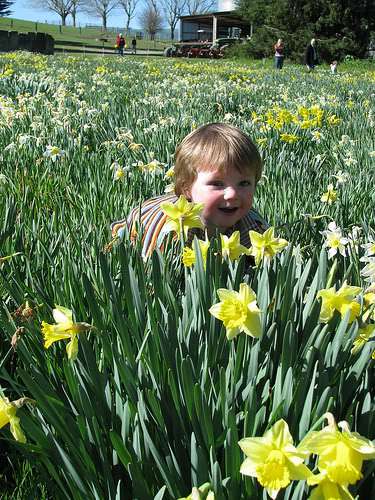
photo by heart felt
I’ve been seeing daffodils everywhere, so it truly must be Spring.
Though crocuses are usually the first to pop up at winter’s end, it’s those showy yellow daffodils, bobbing their heads in the breeze and trumpeting Spring’s arrival, that makes it official.

Wordsworth portrait by William Shuter, 1798
It just so happens that the man who wrote the most famous daffodil poem ever, William Wordsworth, is celebrating his 239th birthday today. You probably know him as the preeminent poet of England’s Lake District, who, along with Samuel Taylor Coleridge, pretty much ignited the Romantic movement.
April must have been a good month for poems even back in the 19th century, because it was on April 15, 1802, that Wordsworth and his sister, Dorothy, visited a friend in Eusmere, and on their walk home to Grasmere, saw “a host of golden daffodils” along the shore of Ullswater.

Ullswater is the second largest lake in the Lake District, considered by many
to be the most beautiful.
Dorothy recorded the experience in her diary, and it is widely believed this formed the basis for Wordsworth’s most well known poem, “I Wandered Lonely as a Cloud,” which he wrote two years later at Dove Cottage.
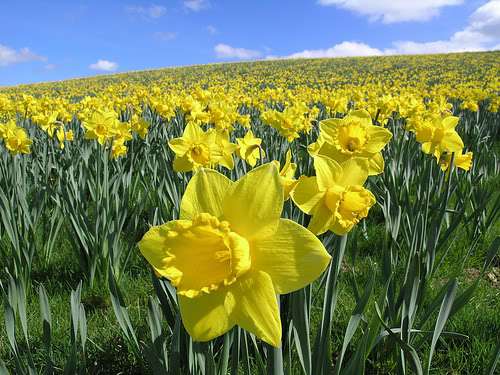
photo by Garry Platt
I first read the poem in high school, then studied Wordsworth in greater depth in college. Yes, I had read the requisite Chaucer, Milton, Shakespeare, Pope and Spenser, like any conscientious English major. But it wasn’t until my class in the Romantics that I became wholly enamored with poetry.
Finally — poetry that emphasized and valued the inner emotions of the poet, with diction that resembled natural speech! Poetry that focused on “incidents and situations from common life,” that was colored by the imagination, “whereby ordinary things should be presented to the mind in an unusual way.”
Yes! Enough of elevated language that placed the reader at a distance. Enough of archaic forms and structures that excluded readers rather than engaged them! Wordsworth’s intent in writing poetry that spoke to the common man in his own language, a poetry of sincerity and passion rather than stilted artifice (as outlined in his Preface to the Lyrical Ballads), was, in some ways, a reaction against the adverse effects of urbanization, industrialization, mass media, and mass culture:
He attributed to imaginative literature the primary role in keeping the human beings who live in such societies emotionally alive and morally sensitive. Literature, that is, could keep humans essentially human. (Norton Anthology of English Literature, Vol. 2, Eighth Edition).
And in order to do this, poetry must be, above all things, accessible.
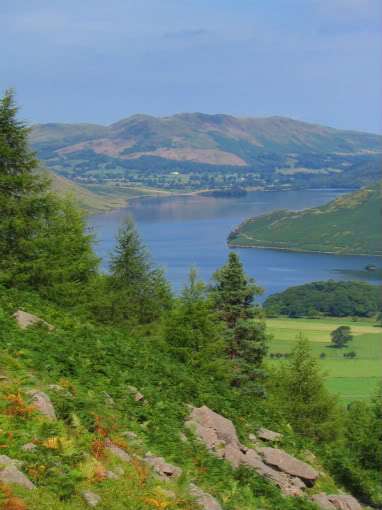
Another view of Ullswater.
“I Wandered Lonely as a Cloud” is much more than an iconic poem everybody knows or memorizes. In a small space of four stanzas, it encapsulates the essential elements of Wordsworth’s new and experimental Romantic theory: simple language, a rustic setting, focus on the poet’s emotional reaction to nature, the crucial role of the imagination in spawning “emotion recollected in tranquility,” thereby validating the inherent power and resonance of instinctual, elemental sensibilities.
The fact that this poem is now largely part of our DNA, whether we claim to be poetry lovers or not, proves Wordsworth correct. The purest, truest human feelings have the best chance of being accurately conveyed in a language utilized by the common man.
While living in England years ago, I finally got to visit the Lake District for myself. It was definitely one of those “dreams-come-true” experiences. We saw Beatrix Potter’s Hill Top Farm in Near Sawrey, and the spectacular ruins of Tintern Abbey. And then — there was Dove Cottage itself, originally an inn called the Dove and Olive, preserved just as it was when Wordsworth, Dorothy, and his wife, Mary, lived there between 1799-1808.
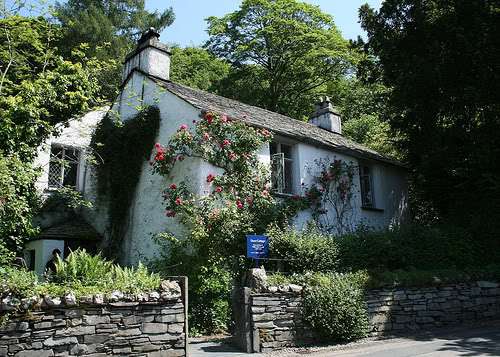
Dove Cottage (photo by Paul Tuna Turner)
As I stood on those flagstone floors and gazed at the dark paneling and white washed walls, I thought how miraculous it was, that a girl from Hawai’i who so loved this poet and once marked her textbooks with extensive marginalia and memorized countless lines, should now be there in the very house where he wrote his greatest poems, where his sister wrote her journals, where Coleridge and other leading figures of the day frequented almost 200 years before.
This experience alone made my long journey to England worth it. Book study is one thing, being there in person quite another. When I saw how the light filtered through the windows, how the air felt and smelled — the poems I knew only from books finally came alive. The imagination that Wordsworth had time and again touted as man’s supreme gift, has ever since enabled me to see, understand, and endure.
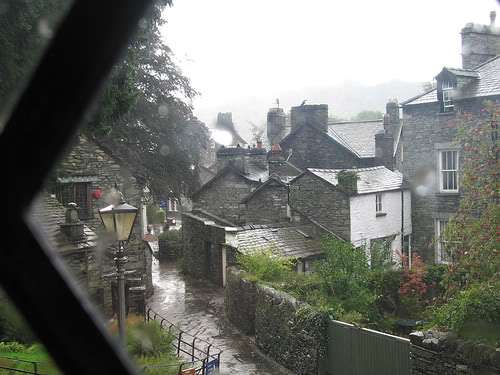
View from Dove Cottage (photo by Ichabod2)
Though today we might take for granted the value and privilege of individual creativity and innovative freedom, it is worth remembering those who challenged existing doctrines and through their innovations revolutionalized the poetical landscape. I am reminded of this every spring with the daffodils. How about you?

I WANDERED LONELY AS A CLOUD
by William Wordsworth
I wandered lonely as a cloud
That floats on high o’er vales and hills,
When all at once I saw a crowd,
A host, of golden daffodils;
Beside the lake, beneath the trees,
Fluttering and dancing in the breeze.
Continuous as the stars that shine
And twinkle on the milky way,
They stretched in never-ending line
Along the margin of a bay:
Ten thousand saw I at a glance,
Tossing their heads in sprightly dance.
The waves beside them danced; but they
Out-did the sparkling waves in glee:
A poet could not but be gay,
In such a jocund company:
I gazed – and gazed- but little thought
What wealth the show to me had brought:
For oft, when on my couch I lie
In vacant or in pensive mood,
They flash upon that inward eye
Which is the bliss of solitude;
And then my heart with pleasure fills,
And dances with the daffodils.
Happy Birthday, Mr. Wordsworth!
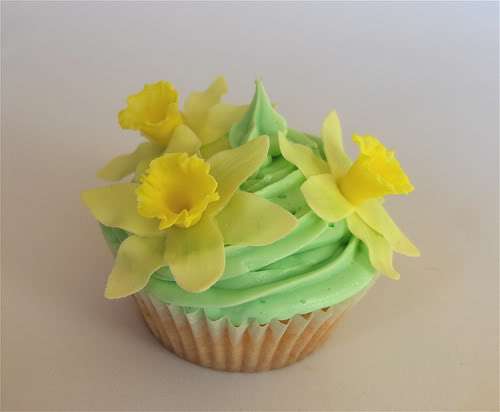
photo by abbietabbie
To read Dorothy’s journal entry and hear a reading of the poem, click here.
Kelly Fineman has written numerous posts about Wordsworth. Read her excellent explication of “I Wandered Lonely as a Cloud,” here, and her ruminations on “Ode: Intimations of Immortality From Recollections of Early Childhood,” probably my favorite Wordsworth poem, here.
The Dove Cottage, Wordsworth Museum and Art Gallery has more interesting info on their website.
“Fill your paper with the breathings of your heart.” ~ Wordsworth

Funny, I missed the crocuses this spring. I long for daffodils in February and buy bunches in the grocery store. Did you know that Gloucester County in Virginia has daffodil farms? It’s the county’s main industry, I think. Gorgeous photogs, as always.
LikeLike
“And then my heart with pleasure fills
And dances with the daffodils”
*happy sigh*
I adore this poem, as you already know. And his Ode may be my favorite as well (it certainly was my favorite Wordsworth poem when I was in high school, and remains among my favorite poems in general).
LikeLike
Didn’t know about the daffodil farms in Gloucester County. Cool!
Daffodils are the only flower the deer allow us to have. It’s funny scouting the neighborhood — only daffodils in everyone’s yard :).
LikeLike
The Ode had me swooning in high school, too. The whole “splendor in the grass thing” was pretty cool. Love your userpic :). . .
LikeLike
daffodils and poetry
London was lovely, but you took away my breath with the trip north to the Lake District! I loved hanging with the younger Jama getting choked up in Dove Cottage.
and thank you for this:
“Fill your paper with the breathings of your heart.”
LikeLike
Re: daffodils and poetry
I’m getting choked up because I wanna BE the “younger Jama!” Where did she go? Why did she have to leave? 🙂
The whole England experience was mind boggling to me. So many things I read about became real. I visited my fair share of author homes, but of course I hope to go back to see even more.
LikeLike
Oh, Jama. What a wonderful post.
I’m going to get some daffodils for my table today.
In honor of Wordsworth (he really did get the greatest name ever, didn’t he???) and you!
LikeLike
Daffodils & Wordsworth & England
Elaine M.
What a fantastic post for National Poetry Month! Thanks so much. I love daffodils. They always remind me of the return of spring–their bright yellow flowers shining like small suns in gardens. I enjoyed reading about Wordsworth and his approach to writing poetry.
My husband and I traveled through England and Scotland in 1972. We loved it there–especially the Lake District, the Cotswolds, Edinburgh, and Inverness…I could probably go on.
Great photos!!!
LikeLike
Re: daffodils and poetry
I know the younger Jama is still around. If you ever want a travel companion back to England, let me know.Seriously.
LikeLike
Re: daffodils and poetry
Will do!
LikeLike
Truly, what are the chances of being named “Wordsworth?!” Enjoy your daffs, Liz! 🙂
LikeLike
Re: Daffodils & Wordsworth & England
Sigh. You know well, then, of what I speak. The Cotswolds were amazing, too. My mom and I rode the train up to Edinburgh and Inverness. Nessie wasn’t there, though . . .
LikeLike
What beautiful photos!
At first I thought it was your birthday, until I opened up the post.
Thanks for sharing this poem–it is a great way to welcome spring.
LikeLike
Oh, Jama. Thank you so much for this beautiful post. Thank you for reintroducing me to William Wordsworth and his work. I haven’t talked to William in such a long time. Do you think he’ll forgive me? :o(
Tarie
Into the Wardrobe
LikeLike
Do I look like I’m 239 years old? 😀 Thanks for reading, Vivian. Happy Spring!!
LikeLike
I’m sure William will forgive you if you read or recite his daffodil poem to at least 3 people today :).
LikeLike
Tanita Says 🙂
Glorious. I’m getting to the Lake District for the first time this summer — I know the daffs will be gone by then, but I’m enjoying the hordes of them that even grow by the freeway in Scotland.
LikeLike
Re: Tanita Says 🙂
Oh, you’ll love it! It’s such a gorgeous area, with lots of literary connections.
LikeLike